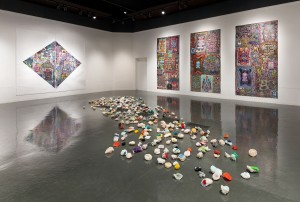“Language” explores words in visual form
The USC Fisher Museum of Art’s current exhibit, “Drawn to Language,” blurs the intersection between language and art. This mixed media exhibition, which opened Sept. 3 and runs until Dec. 7, explores the relationships each artist has to language. Ranging from literal to textual to more symbolic depictions, “Drawn to Language” makes viewers question the power of words and the role they play in shaping art.

Say what? · Artist Alexandra Grant plays with the concept of self image in her piece “Century of the Self.” The piece creates the effect of words as they would be said before a mirror by employing the effect on hand-painted words. “Drawn to Language” runs at Fisher Museum until Dec. 3. – Courtesy of Brian Forrest
Upon entering, viewers are greeted with Kate Ingold’s “Thesaurus for Ceasing War” and “21st Century Retablo” series. The most striking piece in Ingold’s “Thesaurus” is the embroidered silk photographic panels. The photographs of a building in the process of construction are interlaced with metallic threads. An original poem accompanies the panels. The muted palette of the work adds to its ephemerality and suggests the intangibility of language. Ingold’s other pieces echo similar themes, featuring original poetry and photographs interlaced with metallic threads. While its ties to language are not overt, “Thesaurus for Ceasing War” sends a powerful message about how words can be used to promote nonviolence.
“21st Century Retablo” mirrors Ingold’s other work and depicts the 2005 apparition of the Lady Guadalupe beneath a bridge in Chicago. The term “retablo” refers to offerings or requests made to Christian saints. This raises the question of the language of faith and how people feel words (i.e., prayer) connect them to deities.
Demián Flores and Lila Downs’ collaboration on “Pecados y Milagros (Sins and Miracles)” also addresses the connections between language and religion. This project invited contemporary artists to create traditional Mexican votive candles, which feature images and prayers. In addition to the contemporary pieces, the Fisher Museum also displays traditional votivos for comparison. The “Pecados y Milagros” collection delves further into the realm of language with Lila Downs’ album by the same title. Similarly to the contemporary votivos, the album explores themes of tradition and language. This multifaceted approach to language makes “Pecados y Milagros” one of the most intriguing collections on display.
In the adjacent room, Holly Downing and David St. John’s “Peruvian Portals, A Cross-Cultural Hymn,” reflects ancient tradition and modern language. A 2006 trip to the Andes inspired Downing to create mezzotint engravings of the doorways and archways she encountered. St. John was drawn to Peruvian culture after reading poems translated from the ancient language, Quechua. The exhibition has an audio component, which allows patrons to hear one of St. John’s poems, “Doorway Song,” spoken in Quechua. Like “Pecados y Milagros,” this collection uses different languages to express the same idea — making viewers reflect on the superficiality of language barriers. Additionally, St. John will present his poetry live on Wednesday, Oct. 23 at Fisher. “The Peruvian Portals” collaboration matches images with poems and was published as a book by the same title.
Books can be thought of as the epitome of collected language; they weave complex stories but can also be art in themselves. Artist Susan Silton crafts a collection that revolves around the physical aspects of language. Her installation, “In Everything There Is a Trace,” uses ribbon-less typewriters to impress text onto pages. The focal point of the collection is a site-specific installation of 10 typewriters arranged in a circle. Visitors can sign up to participate in the ribbon-less retyping of John Steinbeck’s The Grapes of Wrath on select Fridays at the museum. Instead of setting traditional type on the paper, the pages will bear subtle impressions of the text. Silton’s collection also includes catalog pages impressed with poems and mounted in movable wall frames. These pieces serve as a reminder that before the age of the computer, word processing involved more effort and left physical rather than just visual traces on the page. Silton’s collection encapsulates the essence of the “Drawn to Language” exhibition. With its clear focus and coherent yet creative execution, “In Everything There Is a Trace” prompts viewers to reimagine the way language is recorded.
Artist Alexandra Grant draws on similar themes of literature and texture in “Century of the Self.” Grant explores the connection between language and self-definition by quoting lines from literary classics such as Sophocles’ Antigone and Shakespeare’s Hamlet. Grant incorporates these phrases in large, colorful paintings and plays with mirror images and reflection. Her wall pieces seem reminiscent of street art and hint at the ubiquity of famous literary phrases. In continuing with her exploration of the self, Grant uses colorful pieces of recycled plastic to create a Rorschach inkblot test (a psychological test that observes participant’s interpretation of inkblot patterns) on the museum floor. Similar to Silton’s site-specific installation, this piece invites viewer interaction. Grant will present her work at the museum on Oct. 20. Grant’s work has the least concrete ties to language, yet “Century of the Self” still contributes to the exhibition as a whole by adding kaleidoscopic colors and unexpected texture.
“Drawn to Language” addresses the ways in which artists connect with language — it shows that words have the ability to move beyond the page. Fisher presents many opportunities for multimedia engagement with language through a series of related events. For the duration of the event, Fisher will host concerts, artist talks and poetry readings to add another facet to the exhibit. These multimedia events all center on language but allow visitors to step away from the page and consider words in different contexts.
“Drawn to Language” official opening will take place on Thursday, Sept. 26 and will include a speech by the museum director, as well as a chance to meet some of the artists.
Follow us on Twitter @dailytrojan
